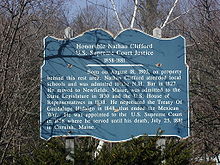This article needs additional citations for verification .(January 2023) |
- 1 2 "Justices 1789 to Present". Washington, D.C.: Supreme Court of the United States. Retrieved February 15, 2022.
- ↑ The National Cyclopaedia of American Biography. Vol. II. James T. White & Company. 1921. p. 473. Archived from the original on May 13, 2021. Retrieved May 13, 2021– via Google Books.
- ↑ Gillette, William. The Justices of the United States Supreme Court, 1789-1969, Their Lives and Major Opinions. Edited by Leon Friedman and Fred L. Israel. Vol. II. New York: Chelsea House in Association with Bowker, 1969. 963.
- ↑ A Small Gore of Land, Merrill, Gowan et al. 1977.
- 1 2 Gillette, William. The Justices of the United States Supreme Court, 1789-1969, Their Lives and Major Opinions. Edited by Leon Friedman and Fred L. Israel. Vol. II. New York: Chelsea House in Association with Bowker, 1969. 964.
- ↑ Gillette, William. The Justices of the United States Supreme Court, 1789-1969, Their Lives and Major Opinions. Edited by Leon Friedman and Fred L. Israel. Vol. II. New York: Chelsea House in Association with Bowker, 1969. 966.
- ↑ "Clifford, Nathan". Washington, D.C.: Federal Judicial Center. Retrieved February 15, 2022.
- ↑ Bosch, William. The Supreme Court Justices, A Biographical Dictionary. Edited by Melvin I. Urofsky. New York: Garland Publishing, 1994. 123.
- ↑ McMillion, Barry J. (January 28, 2022). Supreme Court Nominations, 1789 to 2020: Actions by the Senate, the Judiciary Committee, and the President (PDF) (Report). Washington, D.C.: Congressional Research Service. Retrieved February 15, 2022.
- 1 2 Gillette, William. The Justices of the United States Supreme Court, 1789-1969, Their Lives and Major Opinions. Edited by Leon Friedman and Fred L. Israel. Vol. II. New York: Chelsea House in Association with Bowker, 1969. 968.
- ↑ A Few New Hampshire Notables Archived July 24, 2011, at the Wayback Machine USDC - District of New Hampshire.
- 1 2 Gillette, William. The Justices of the United States Supreme Court, 1789-1969, Their Lives and Major Opinions. Edited by Leon Friedman and Fred L. Israel. Vol. II. New York: Chelsea House in Association with Bowker, 1969. 968–972.
- ↑ Fairman, Charles. History of the Supreme Court of the United States. Vol. VI. New York: Macmillan Company, 1971. 678.
- ↑ Fairman, Charles. History of the Supreme Court of the United States. Vol. VI. New York: Macmillan Company, 1971. 698–700.
- ↑ Fairman, Charles. History of the Supreme Court of the United States. Vol. VI. New York: Macmillan Company, 1971. 716–17.
- ↑ Fairman, Charles. History of the Supreme Court of the United States. Vol. VI. New York: Macmillan Company, 1971. 717.
- ↑ Fairman, Charles. History of the Supreme Court of the United States. Vol. VI. New York: Macmillan Company, 1971. 753.
- ↑ Fairman, Charles. History of the Supreme Court of the United States. Vol. VI. New York: Macmillan Company, 1971. 755–56.
- ↑ Fairman, Charles. History of the Supreme Court of the United States. Vol. VI. New York: Macmillan Company, 1971. 758.
- ↑ Fairman, Charles. History of the Supreme Court of the United States. Vol. VI. New York: Macmillan Company, 1971. 762–3.
- ↑ William DeGregorio, The Complete Book of U.S. Presidents, Gramercy 1997.
- ↑ Gillette, William. The Justices of the United States Supreme Court, 1789-1969, Their Lives and Major Opinions. Edited by Leon Friedman and Fred L. Israel. Vol. II. New York: Chelsea House in Association with Bowker, 1969. 974.
- ↑ "Archived copy" (PDF). Archived (PDF) from the original on September 27, 2016. Retrieved September 17, 2016.
{{cite web}}: CS1 maint: archived copy as title (link) - ↑ Huebner, Timothy S. The Taney Court Justices, Rulings, and Legacy. Santa Barbara, California: ABC-CLIO, 2003. 103.
- ↑ Gillette, William. The Justices of the United States Supreme Court, 1789-1969, Their Lives and Major Opinions. Edited by Leon Friedman and Fred L. Israel. Vol. II. New York: Chelsea House in Association with Bowker, 1969. 963–4.
- ↑ "Hon. Nathan Clifford". Watertown Republican. July 27, 1881. p. 4. Archived from the original on May 13, 2021. Retrieved May 13, 2021– via Newspapers.com.
- ↑ "Funeral of Justice Clifford". Chicago Inter Ocean . Portland, Maine. July 29, 1881. p. 2. Archived from the original on May 13, 2021. Retrieved May 13, 2021– via Newspapers.com.
Further reading
- Clifford, Philip G., Nathan Clifford, Democrat from 1803 to 1881, New York: G. P. Putnam's Sons, 1922.
External links

- United States Congress. "Nathan Clifford (id: C000518)". Biographical Directory of the United States Congress .
- Nathan Clifford at the Biographical Directory of Federal Judges , a publication of the Federal Judicial Center.
Nathan Clifford | |
|---|---|
 Clifford c. 1855–65 | |
| Associate Justice of the Supreme Court of the United States | |
| In office January 21, 1858 –July 25, 1881 [1] |



